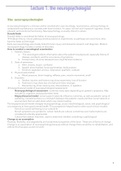Summary
Summary neuropsychology of the book and lectures
- Course
- Institution
- Book
Summary of the lectures and book for the course neuropsychology. I have made a summary using the important key points that were given at the end of the lectures. I will update the document weekly, so you will have enough time to study the document before the exam :)!!!
[Show more]




